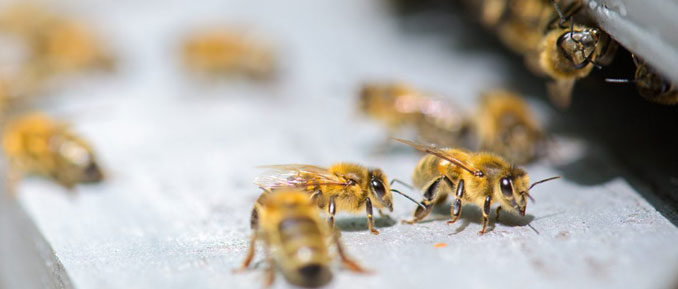
Bees, like humans, have been known to act…well, buzzed when given cocaine. And just like us, they can also become addicted to it…even suffer from withdrawal symptoms when the drug is taken away. It’s this similarity in altered behavior to us that makes them a great model system to study when investigating the effects of cocaine use.
As it just so happens, researchers from Norway and Australia recently conducted a study using honey bees to investigate cocaine dependency. Not the first bees on cocaine study, but definitely one of the few to explore epigenetics. Their findings were published in the February issue of Frontiers in Physiology.
Drug addiction is a complex illness that is often plagued with reoccurring relapse, making recovery a challenging endeavor. Considered by many to be a behavioral disorder and treated as such, addiction has also been interpreted as a neurological disorder that affects the brain’s reward circuitry. Certain drugs create heightened associated-drug memories that can trigger strong cravings leading to continual addictive behavior. In some cases, these memories can last after detoxing from the drug for an unusually long time.
Cocaine has this effect. Its high incentive salience, or wanting for it, is quickly developed in the brain when under the influence. Previous research has shown that cocaine affects the neural circuits in the brain by disrupting the epigenetic machinery involved in memory processing. Specifically, it affects DNA methylation patterns which are facilitated by DNA methyltransferases (DNMTs). However, it is not entirely known whether or not cocaine affects memory processing directly, that is separately from its effect on incentive salience.
To determine this, the researchers of the current study decided to look at how cocaine affects bee learning and memory without it being associated as a reward. Using a form of classical conditioning related to the insect’s feeding behavior, they investigated the drug’s effect at the various stages of memory formation including acquisition, consolidation, and retrieval. They then examined the bee brains for any changes in DNA methylation.
In nature, honey bees learn and memorize certain cues that characterize things of interest such as flowers or the hive. In the lab setting, their learning ability can be studied using a well-established paradigm: the olfactory conditioning of the proboscis extension reflex (PER). As done in this study, PER basically uses sugar water as stimuli to make the bees stick out their straw-like tongues (or proboscis) to drink, which is then paired with a particular odor. An adverse reaction can be achieved using a salt solution.
Here, the bees were exposed to differential conditioning, pairing one scent with reward (sugar water) and another with punishment (salt solution), as well as absolute conditioning, pairing only a single scent to a reward. Training and testing for both acquisition and extinction learning was conducted and the bees were given cocaine sporadically throughout the study to diminish any interference with reward perception.
Following testing, the bee brains were analyzed for DNA methylation activity using a commercial DNMT activity and inhibition assay. In addition, transcription levels for DNA methyltransferase 3 (AmDNMT3) and TET dioxygenase (AmTET) were assessed. While no change in AmDNMT3 was detected, a single dose of cocaine did alter DNA methylation enzyme activity levels and AmTET transcription.
The most surprising outcome that the authors noted was the context dependency of the effects of cocaine on AmTET. Their report stated, “We can only speculate why levels were shown to increase in animals following acquisition conditioning, while they were decreased in naïve animals and animals that had gone through extinction training, but it is a clear demonstration that when considering how drugs of abuse might interact with the DNA methylation/demethylation machinery it is important to remember that what the animal is actively doing or exposed to can play an important role.”
Overall, the primary findings from the study showed that cocaine had the greatest impact on consolidation of extinction memory, most likely via alterations in AmTET levels. The authors wrote, “This suggests that part of the reason why cocaine-associated memories are so hard to extinguish, could be that in addition to increasing the incentive salience of stimuli, cocaine also actively inhibits consolidation of extinction.”
Because this study gives evidence that cocaine epigenetically interferes with extinction learning, it may appear to support extinction-based therapies. There’s been strong motivation to use these types of treatments for all sorts of dependencies. However, the researchers suggest that they are not effective for cocaine, especially given its failure rate. Perhaps, if extinction-based therapies were to be combined with other remedies – ones that address the epigenetic machinery, it could have utility in cocaine addiction. Clearly, more research is needed to determine the exact mechanisms involved and to test any potential therapeutic strategies.
Source: Søvik Eirik, Berthier Pauline, Klare William P., Helliwell Paul, Buckle Edwina L. S., Plath Jenny A., Barron Andrew B., Maleszka Ryszard. Cocaine Directly Impairs Memory Extinction and Alters Brain DNA Methylation Dynamics in Honey Bees. Frontiers in Physiology, 9 :79.

